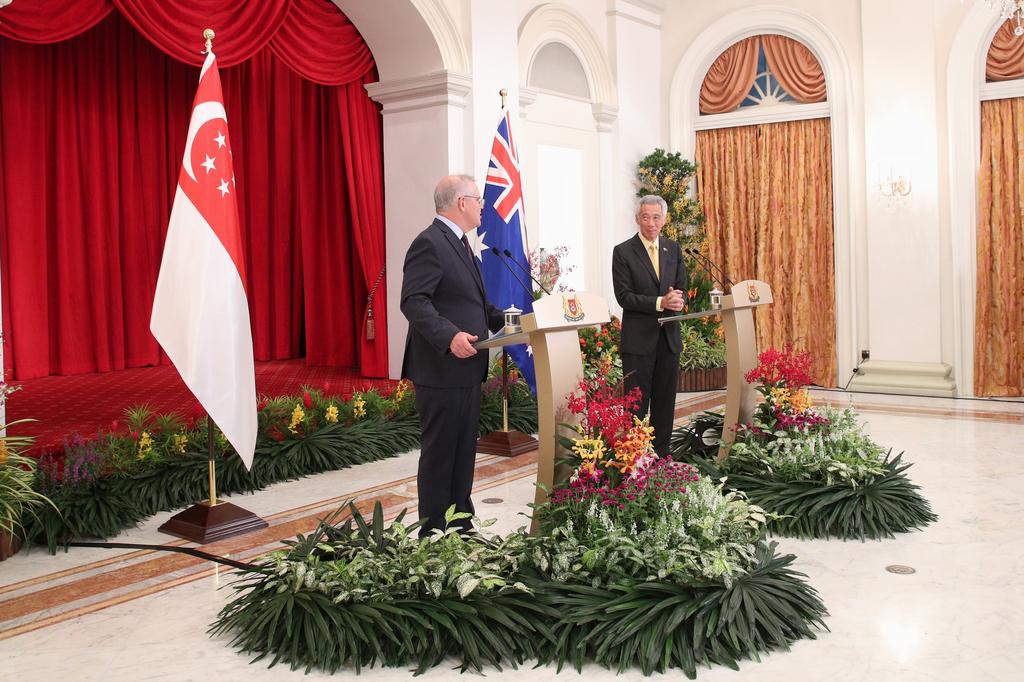SINGAPORE, June 11 — Australia and Singapore are working on plans for an eventual air travel bubble between the two countries with students in the Republic who need to return Down Under to resume their studies set to be used in a pilot for such a bubble.
Prime Minister Lee Hsien Loong discussed this prospect during a meeting with his Australian counterpart Scott Morrison during the 6th Singapore-Australia Leaders' Meeting which was held at the Istana yesterday evening (June 10).
The meeting is held annually under the Comprehensive Strategic Partnership (CSP) signed by both countries in 2015 to strengthen co-operation in trade, defence and people-to-people ties, among other areas.
Speaking at a joint press conference with Morrison after the meeting, Lee said that he knows quite a number of Singaporeans studying in Australia have come home during the pandemic and are unable to go back to Australia to resume their studies.
“There is urgency for them,” he said, noting that it is especially disruptive for those who have clinical attachments or postings, and are unable to take them up during this period.
“So I raised this with the Prime Minister and Prime Minister Morrison was very generous to say yes, it is on his mind and he is minded to do that as his first priority.
“I said, that's one way to test out our systems and get a pilot going so that we can widen the project, and later on, have a full travel bubble between the two countries.
Agreeing, Morrison said : “We really do want to focus on those students coming as a first wave, the first tranche as part of the exercise — piloting how these systems can work most effectively when we get to the next phase.”
Morrison stopped over in Singapore briefly yesterday, en route to the Group of Seven (G7) summit in Britain. Australia is not a member of the G7, but has been invited to attend.
Lee added that there is “no timetable” so far on when the potential pilot would occur, but the two prime ministers “hope it can be done as soon as possible”.
The Ministry of Foreign Affairs (MFA) said in a statement that the two prime ministers “reaffirmed the excellent state of bilateral relations and their shared commitment to strengthen the Singapore-Australia CSP”.
MFA added that Lee and Morrison discussed how Singapore and Australia can resume two-way travel in a safe and calibrated manner, with priority for students, when both sides are ready.
“They welcomed the ongoing discussions between officials on both sides on a possible air travel bubble and the mutual recognition of health and vaccination certificates,” the ministry said.
Other than health and vaccination certificates, Lee said that vaccination rates will be part of the consideration in deciding on when to open a travel bubble between the two nations.
The transmission rates of the virus will “also be a factor and we watch it carefully”, said Lee.
Morrison also made clear that Singapore is the first country other than New Zealand that it would open a travel bubble with. Australia and New Zealand have been operating a travel bubble since April.
“The sophistication of the systems both in Singapore and Australia I think will enable both countries to ensure that we can get a system that works incredibly well,” Morrison said.
Lee added: “What we want to do is to get the preconditions, the infrastructure ready, the vaccine recognition — what are the standards, what are the conditions? Then the actual decision to do it, that is a political decision.
“But let's get everything teed up so that we are in a position to make the political decision when we want to do so.”
The prime ministers were also asked by the media if they have any concerns with the vaccination rates in developing nations in the region.
Lee noted that Singapore participates in Covax, an initiative by the World Health Organisation to ensure equitable access to Covid-19 vaccines worldwide, and has made substantial donations to the programme.
Singapore also acts as a hub for distributing vaccines to the region, including those produced in Australia, he said.
Aside from the proposed air travel bubble, the two leaders tackled various other issues:
The two countries have agreed on a low emissions maritime and shipping initiative, a public-private partnership, with an initial contribution of up to A$30 million (RM95.9 million). The source of the funds was not spelt out. This will enable both countries to work together on low-emissions fuels and technologies, including clean hydrogen, to drive down emissions in maritime shipping and port operations.
The start of negotiations on an Australia-Singapore FinTech Bridge, which will enhance co-operation on financial technology (FinTech) policy and regulation and collaboration on joint innovation projects. It will also facilitate investments and new business opportunities in digital trade and financial services.
Singapore’s Ministry of Health and the Australian Government Department of Health have agreed to sign a new memorandum of understanding to enhance co-operation and collaboration on healthcare and health technologies. This will facilitate deeper exchanges of information, knowledge and expertise including in the areas of health technology assessment to support timely and affordable access to medicines and health technologies for Singaporeans and Australians.
The last Singapore-Australia Leaders’ Meeting was held via video-conference in March last year owing to the Covid-19 pandemic.
The two countries had then agreed to continue sharing best practices to tackle the Covid-19 pandemic, and agreed to keep markets open and supply chains functioning.
“The prime ministers noted the good progress made in the CSP over the past year despite challenges presented by Covid-19,” said MFA in its statement. ― TODAY






















